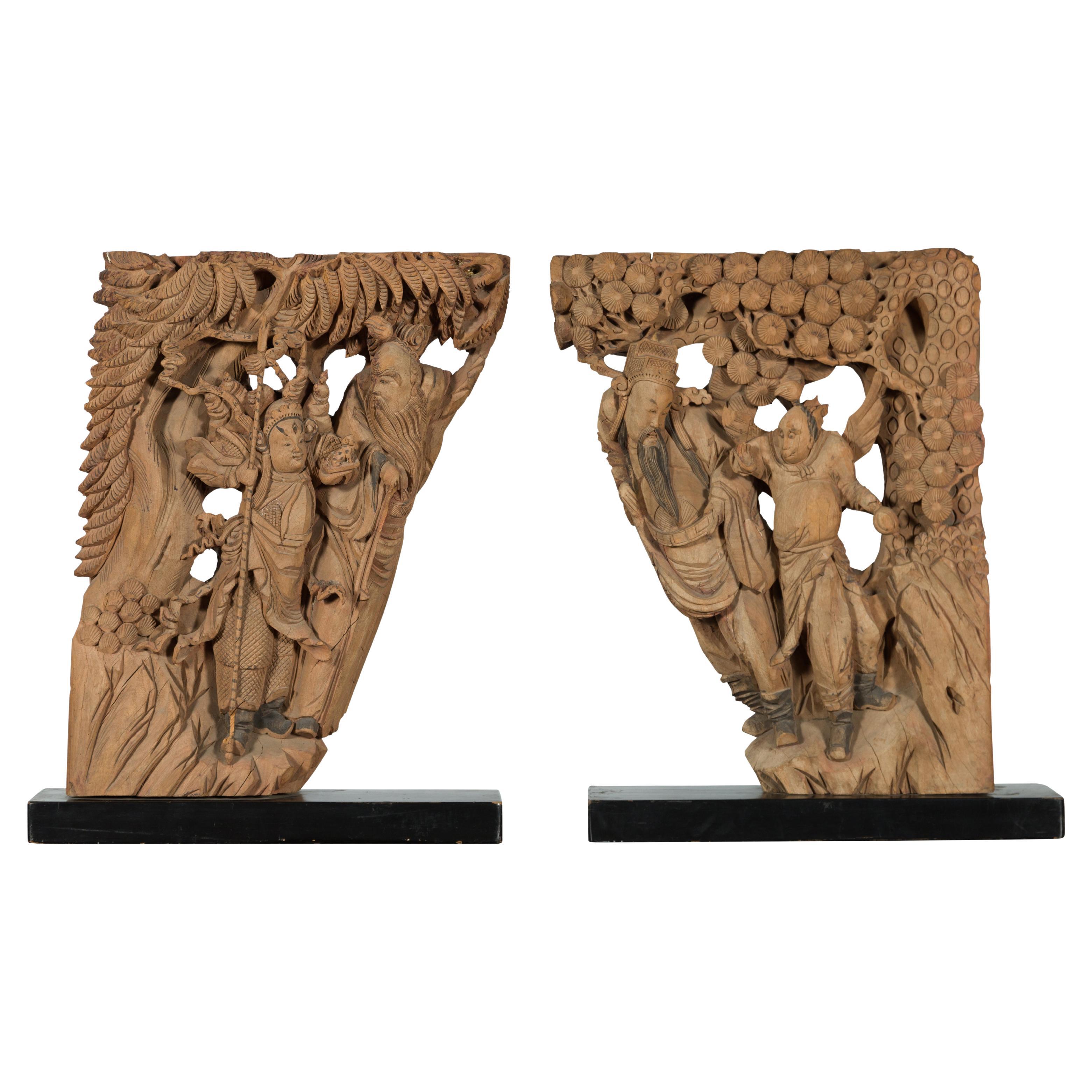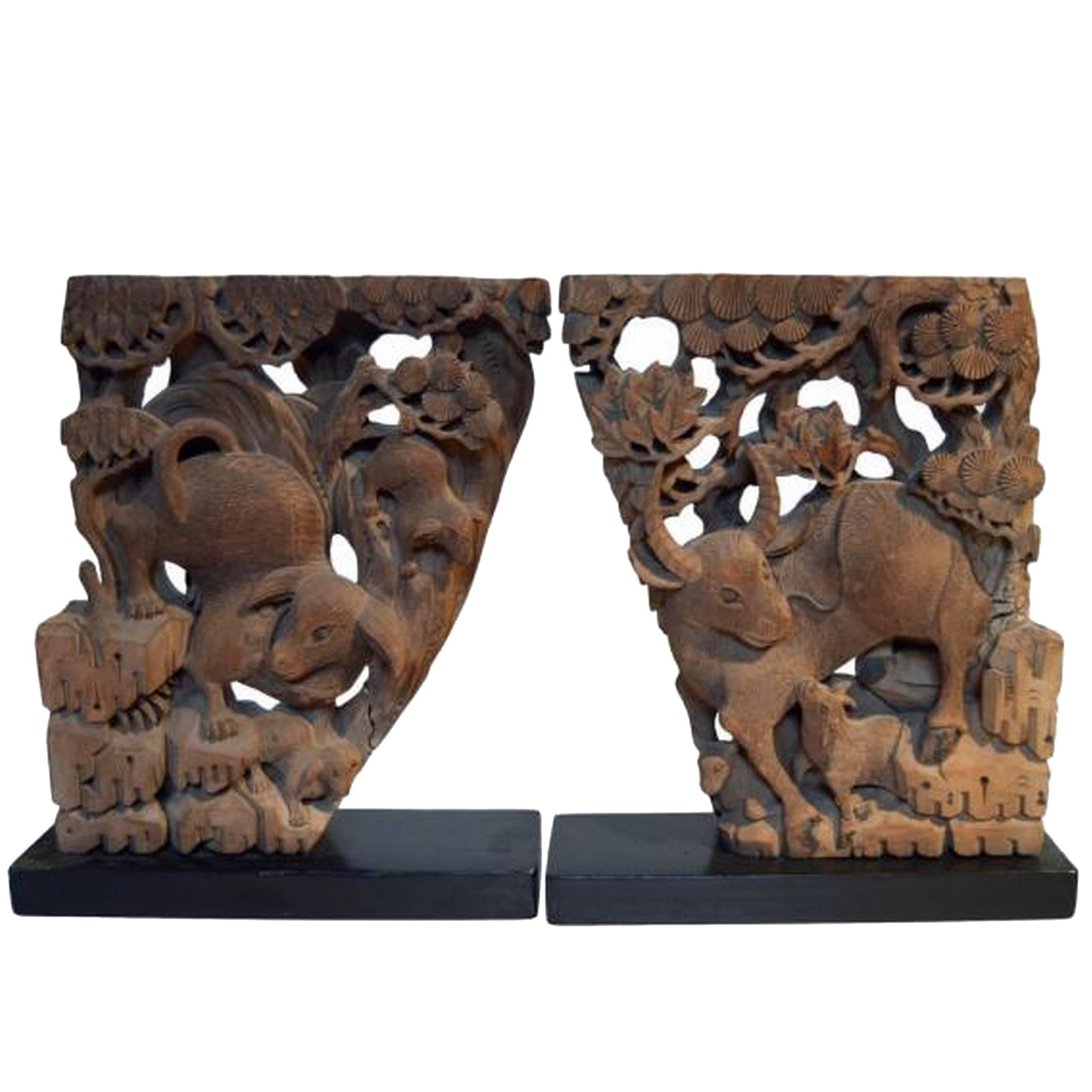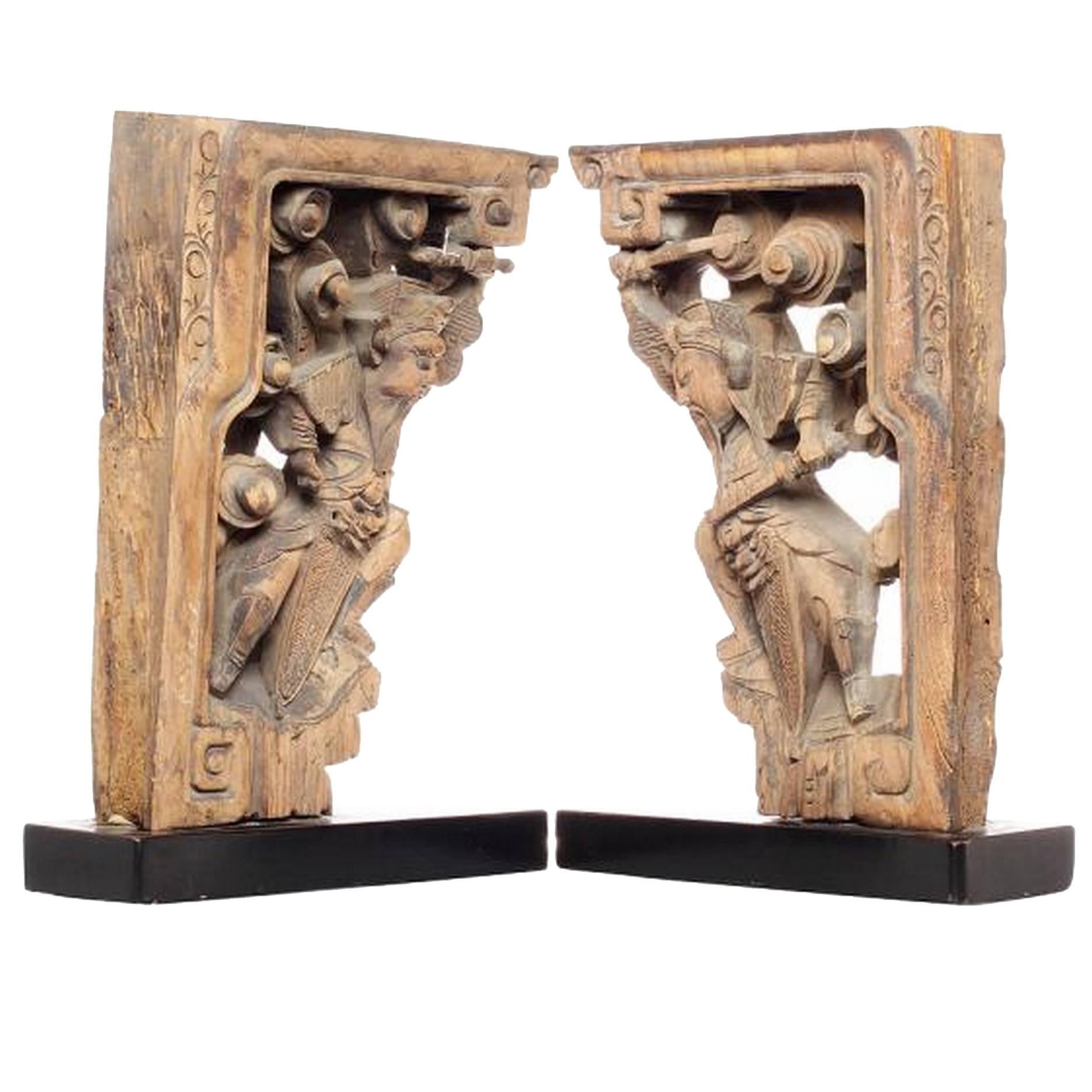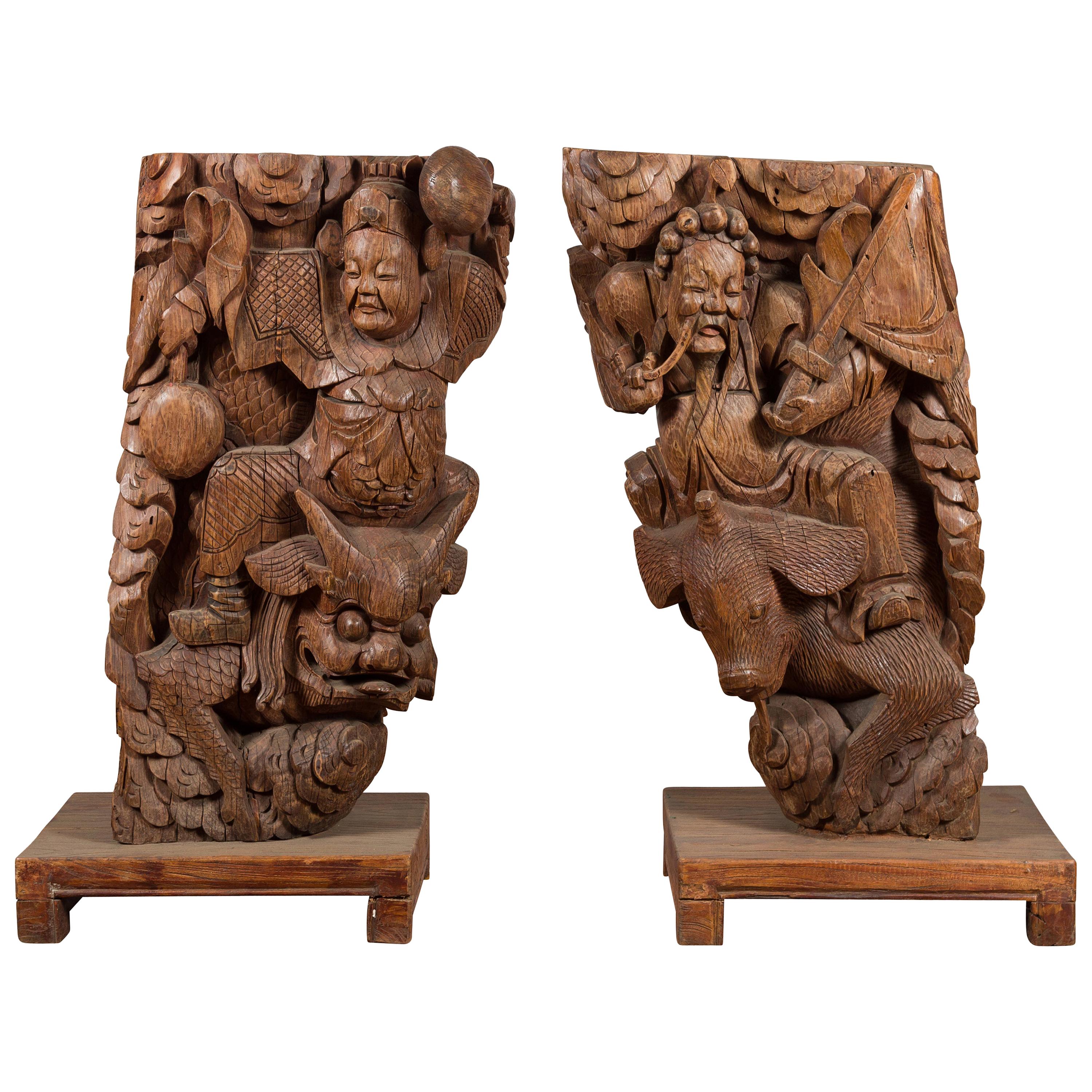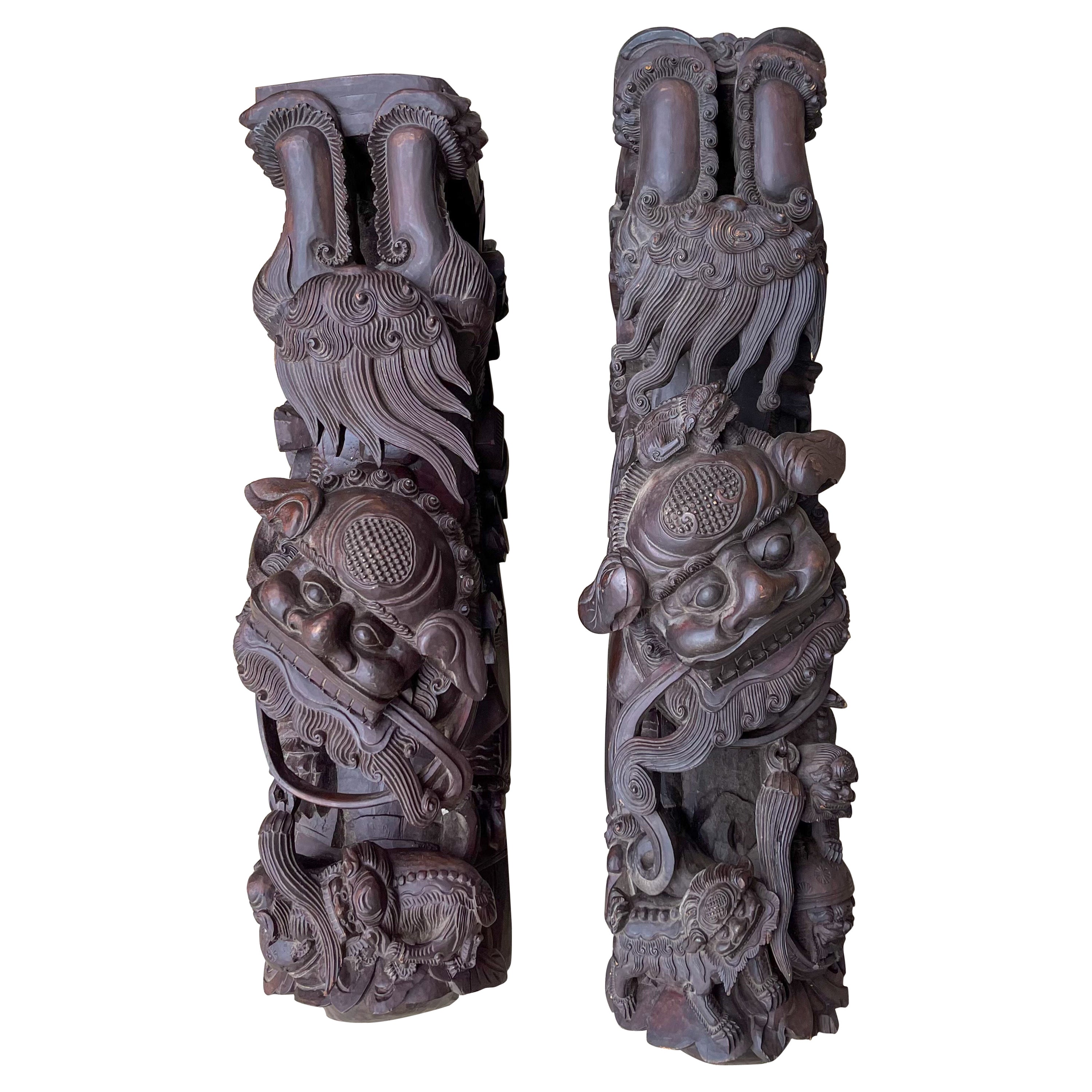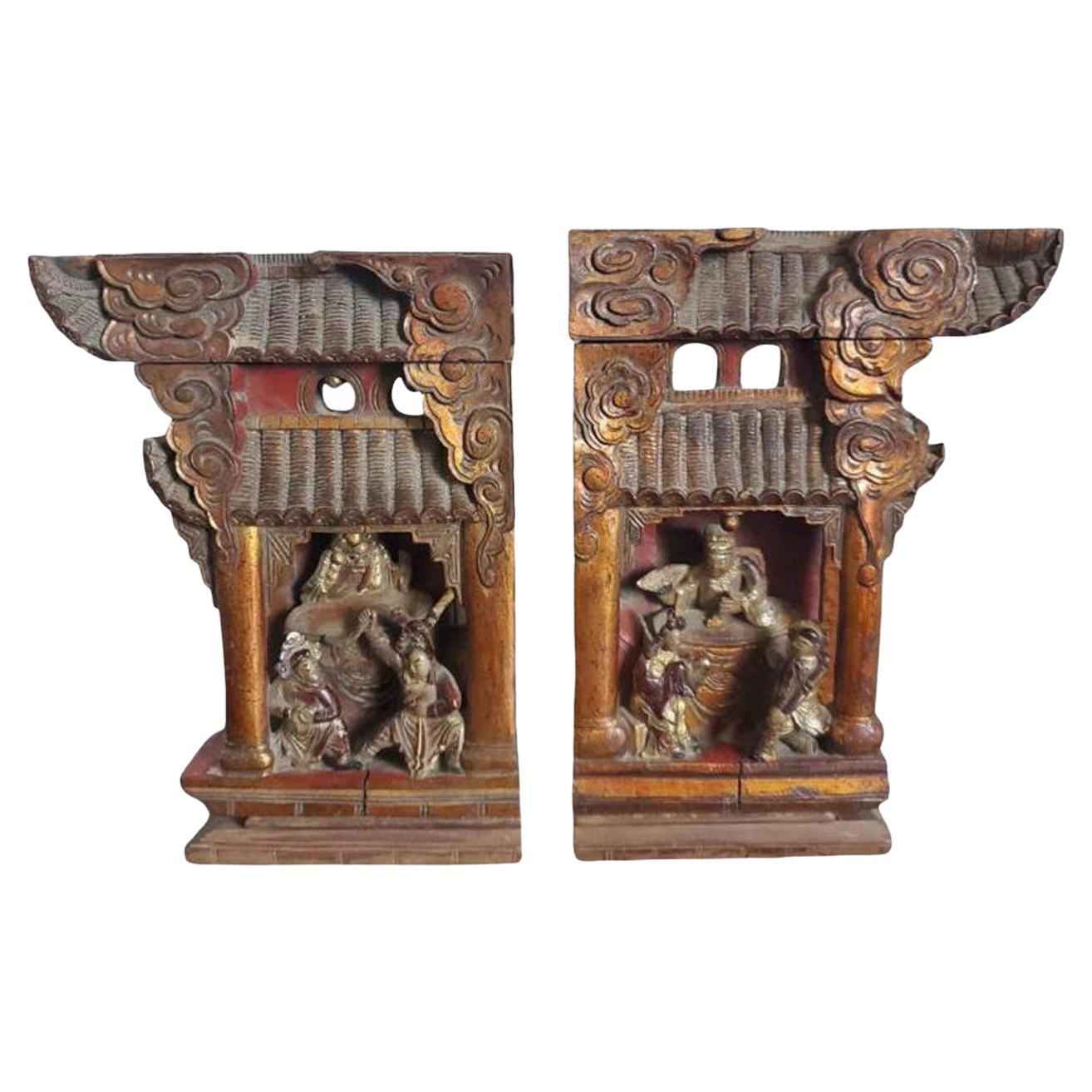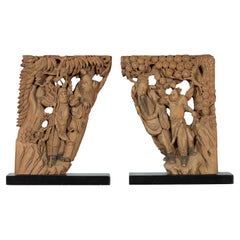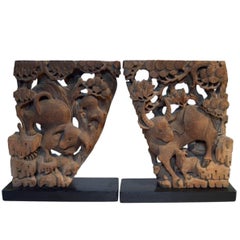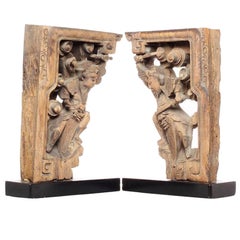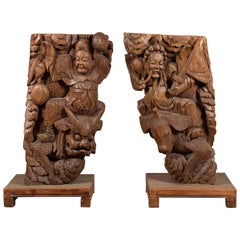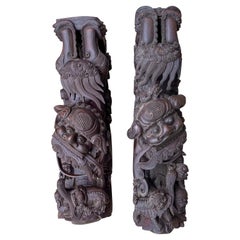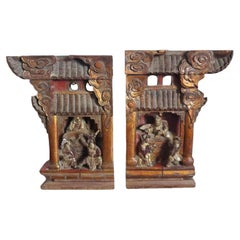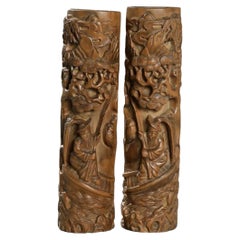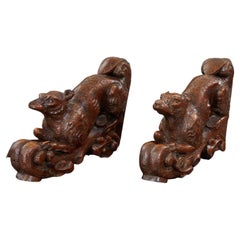Items Similar to Pair of Qing Dynasty Hand-Carved Wooden Temple Corbels with Deer Motifs
Want more images or videos?
Request additional images or videos from the seller
1 of 17
Pair of Qing Dynasty Hand-Carved Wooden Temple Corbels with Deer Motifs
$2,400per set
£1,819.53per set
€2,097.44per set
CA$3,380.01per set
A$3,748.19per set
CHF 1,969.39per set
MX$45,796.47per set
NOK 24,639.81per set
SEK 23,128.67per set
DKK 15,657.78per set
About the Item
A pair of Chinese Qing Dynasty hand-carved wooden temple corbels from the 18th or 19th century with deer and their young. Originally part of a temple wall, this pair of Chinese corbels from the Qing Dynasty (or earlier), features two deer facing one another and showcasing very dynamic postures. Surrounded by detailed foliage, their back paws still resting on a rocky formation, the deer have textured bodies and antlers. Upon closer inspection, one will notice the baby deer looking lovingly upwards. With their skillfully carved scene and natural finish, this pair of Qing Dynasty temple corbels will be excellent decorative additions to any home!
- Dimensions:Height: 29 in (73.66 cm)Width: 17 in (43.18 cm)Depth: 5.5 in (13.97 cm)
- Sold As:Set of 2
- Style:Qing (Of the Period)
- Materials and Techniques:
- Place of Origin:
- Period:
- Date of Manufacture:18th or 19th Century
- Condition:Wear consistent with age and use. Age appropriate wear and maintenance. Please refer to the various additional photos for further condition detail and contact us with any questions!
- Seller Location:Yonkers, NY
- Reference Number:Seller: YN7360 / FEA Home1stDibs: LU863923625132
About the Seller
5.0
Platinum Seller
Premium sellers with a 4.7+ rating and 24-hour response times
Established in 1964
1stDibs seller since 2009
1,180 sales on 1stDibs
Typical response time: <1 hour
- ShippingRetrieving quote...Shipping from: Yonkers, NY
- Return Policy
Authenticity Guarantee
In the unlikely event there’s an issue with an item’s authenticity, contact us within 1 year for a full refund. DetailsMoney-Back Guarantee
If your item is not as described, is damaged in transit, or does not arrive, contact us within 7 days for a full refund. Details24-Hour Cancellation
You have a 24-hour grace period in which to reconsider your purchase, with no questions asked.Vetted Professional Sellers
Our world-class sellers must adhere to strict standards for service and quality, maintaining the integrity of our listings.Price-Match Guarantee
If you find that a seller listed the same item for a lower price elsewhere, we’ll match it.Trusted Global Delivery
Our best-in-class carrier network provides specialized shipping options worldwide, including custom delivery.More From This Seller
View AllPair of 19th Century Chinese Qing Dynasty Hand-Carved Wooden Temple Corbels
Located in Yonkers, NY
A pair of Chinese Qing Dynasty period hand-carved temple corbels from the 19th century, mounted on black bases. Created in China during the Qing Dynasty...
Category
Antique 19th Century Chinese Qing Figurative Sculptures
Materials
Wood
$6,400 Sale Price / set
20% Off
Pair of Antique Hand-Carved Wood Temple Corbels from 18th Century, China
Located in Yonkers, NY
A pair of Chinese 18th century hand-carved wooden temple corbels. Each corbel features detailed animals, shells, and other adornments among openwork fol...
Category
Antique 18th Century Chinese Antiquities
Materials
Wood
Pair of 19th Century Chinese Hand-Carved Temple Corbels with Characters
Located in Yonkers, NY
A pair of 19th century Chinese hand-carved temple corbels featuring stylized characters. Each corbel showcases a great wood openwork carving featuring a...
Category
Antique 19th Century Chinese Antiquities
Materials
Wood
Pair of Qing 19th Century Hand Carved Wooden Temple Corbels with Warriors
Located in Yonkers, NY
A pair of Chinese Qing Dynasty hand carved temple corbels from the early 19th century, depicting warriors. Created in China during the early 19th centur...
Category
Antique 19th Century Chinese Qing Mounted Objects
Materials
Wood
Qing Dynasty Hand-Carved Wooden Temple Corbel with Detailed Figures
Located in Yonkers, NY
A Chinese Qing Dynasty period hand-carved wooden temple corbel from the 19th century with detailed figures and custom base. Created in China during the ...
Category
Antique 19th Century Chinese Qing Mounted Objects
Materials
Wood
Shanxi 1840s Hand Carved Wooden Corbel with Deities Mounted on Base
Located in Yonkers, NY
A Chinese Shanxi carved wooden corbel from the mid 19th century, mounted on a base and depicting two deities. Born in the Northern Province of Shanxi during the 1840s, this exquisite wooden corbel demonstrates the undeniable skill Chinese artists possessed at the time. Presenting two deities (possibly Zhong...
Category
Antique Mid-19th Century Chinese Qing Sculptures and Carvings
Materials
Wood
You May Also Like
19th-C. Monumental Chinese Carved Food Dog Corbels / Architectural Fragments, 2
Located in Kennesaw, GA
Wow! This is a pair or set of monumental Chinese corbels with heavily carved hanging food dogs and pups. The detail is incredible. The slightly smaller...
Category
Antique Mid-19th Century Chinese Chinese Export Architectural Elements
Materials
Rosewood
Rare Set of Two Qing Dynasty Chinese Architectural Temple Brackets
Located in Forney, TX
An original matched pair of exceptionally carved Chinese temple architectural ornaments, the ornate decorative brackets salvaged from an early Qing Dynasty temple, the richy detailed...
Category
Antique Early 19th Century Asian Folk Art Architectural Elements
Materials
Wood, Lacquer, Paint
Early 20th Century Pair of Chinese Wood Carving Sculptures
Located in North Miami, FL
Presenting an exquisite pair of early 20th-century Chinese wood carvings that exude artistry and cultural richness. These masterfully crafted piece...
Category
Early 20th Century Chinese Sculptures and Carvings
Materials
Wood
$3,475 Sale Price / set
50% Off
Pair of Carved Arts & Crafts Fox Brackets
Located in Greenwich, CT
A pair of Arts & Crafts brackets hand-carved in the shape of pouncing foxes on oak branches. Originally bench or table brackets, they have developed marvell...
Category
Antique Late 19th Century English Animal Sculptures
Materials
Oak
$6,900 / set
Antique Asian Carved Foo Dog Lion Architectural Corbels, a Pair
Located in Forney, TX
A magnificent pair of Qing Dynasty (1644-1912) antique Chinese architectural elements with beautifully aged patina. circa 1900
Most impressive large scale, likely sculptural corbels from a Buddhist temple or imperial palace, late 19th / early 20th century, each intricately hand carved with very fine detailing, similarly styled pair, modeled as guardian foo lion, depicted with outstretched arched body, mouth ajar, clutching floral ball, having elaborate openwork carvings, with scattered remnants of original polychrome paint remaining.
The highly decorative architectural salvaged ornamental building elements presented on custom made hand carved wooden sculpture stands...
Category
Early 20th Century Chinese Qing Architectural Elements
Materials
Wood, Paint
Vintage Asian Hand Carved Foo Dogs - a Pair
Located in West Palm Beach, FL
Add an air of exotic elegance to your decor with this captivating pair of Vintage Asian Monumental Hand-Carved Foo Dogs. This striking duo features intricate details and a beautifully aged patina, making them a statement piece that radiates history and culture. Each Foo Dog is carefully hand-carved, showcasing unique expressions and rich texture, making them perfect as a conversation starter or an eye-catching addition to any space.
Whether you're an avid collector or looking to add a touch of Asian-inspired flair to your home, these monumental Foo Dogs...
Category
Late 20th Century Chinese Figurative Sculptures
Materials
Wood, Paint
$1,950 / set
More Ways To Browse
Antique Corbels
Pair Deer
Wood Furniture With Animal Motif
Baby China
Antique Hand Carved Wooden Animals
Hand Carved Corbels
Wood Corbels
Chinese Carved Wood Animal
Wall Corbel
Wooden Corbels
Carved Wood Deer
Wooden Deer
Chinese Corbels
Antique Chinese Corbels
Pair Of Carved Wooden Corbels
Bookshelf Sculpture
Mid Century Brass Birds
Vintage Feather Birds
